Written by Terry Smith
Our site is reader supported so when you click a link to Amazon we may earn an affiliate commission.
Best algae remover [UK]: Top pool, pond, patio, and aquarium algae remover reviewed
This article was last updated on April 23rd, 2022 at 4:59 am
Since writing this review a couple of years ago, a whole myriad of super products have hit the market making Algae, mould, and moss killers individual niche products so I’ve updated the article accordingly and taken aim at the best algae removers for pools, ponds, patios, aquariums, and fences – pretty much anything with a wood or stone surface that can be attacked by algae and Lichen. The great news is, with the right algae remover, there surfaces can literally be restored to near new condition 🙂 And I apologise for the length of the review. I appreciate you may be looking for an algae remover for just wood, but this article encompasses all surfaces and conditions so is pretty lengthy but you can short cut by checking the best picks for algae removers specific to your requirement.
It seems we humans love to have small bodies of water at home. From goldfish bowls and aquariums, to ponds of all sizes and swimming pools, the country’s gardens and homes are filled aquatic features.
Anyone who has ever owned any of the above, or any other water feature like a fountain, will tell you that there is an ongoing battle between you and algae, and you’d better be ready to go to war or your clear looking pond will soon be looking like a toxic pea soup, your aquarium will be cloudy, and your swimming pool or hot tube will be a lot less inviting, to say the least.
And it’s not just your pond or pool that can suffer an algae invasion. Different kinds of algae can be found all over the garden, and it can be a particularly ugly sight on your patio and decking.
But fear not, for you don’t have to walk into battle empty handed, and there are a ton of effective algae removers to choose from. Some are general purpose herbicides that will get rid of pretty much anything of any surface, while others are designed for a specific use, be it aquariums, patios, or water fountains.
Today, we will go into detail about the types of algae you might come across and how to identify it, how to reduce the risk of algae build up, review the best algae removers for pool, pond, patio, and aquariums, and much more. So, let’s get started by taking a closer look at the enemy.
Our picks for the best algae removers and treatments in the UK:
- Hydra fountain clear: best algae remover for fountains
- Patio Magic Patio Cleaner 5L best algae remover for patio in the UK no question.
- Patio Magic Concentrate: best budget pick
- API prevent algae: best algae remover for aquariums
- Clearwater algaecide best algae remover for pools
- Clear Waters Nishikoi blanket weed treatment: best algae remover for fish ponds
- Pro-Kleen Patio Cleaner Simply Spray & Walk Away Concentrate – best algae remover for wood and fences!
- HG Mould Remover Foam Spray – real before and after proof see the review!
- Jarder Spray & Leave 4 x 5 Litre Concentrate Cleaner professional bulk buy choice
- ULTIMA-PLUS XP Patio Cleaner 5 Litres Super Concentrate
Before we get into the best algae removers and which one is suitable for your surface, here’s a look at genuine before and afters:
What are algae?
You might have a specific image in your mind when you hear the term algae, and for many, it is the sight of the dreaded ‘pond scum’ laying on top of the water and looking menacing. But actually, the word ‘algae’ is an umbrella term used to describe a very wide variety of plants that conduct photosynthesis, but don’t have the roots, stems, and other features that are normally found on plants.
From the tiny Picoplankton, too much larger plants like seaweed, the variation of algae found in both fresh and sea water environments is actually quite staggering, but you will also find multiple forms of algae on dry land too. See that green tinge on your neighbour’s wooden fence? Yup, that’s also algae, as is that stuff that made you slip on your decking last week.
Common types of algae you find in aquariums and ponds
Knowing which type of algae that you are up against is the first step to fighting it, so we thought we’d highlight the most common algae found in aquariums and ponds-
Blue-green algae
Common in freshwater aquariums and garden ponds, blue-green algae are not something you want to let get out of control. Why not? Because, when they bloom, they can not only cover the surface in a slimy layer, but also create toxins that can harm your fish.
Blue-green algae can also cause skin irritation, and other more serious health problems, in humans. Admittedly, this isn’t always the case, but it is potentially a problem, so getting rid of blue-green algae early should be a priority.
Funnily enough, blue-green algae are not actually algae at all, but a type of cyanobacteria, but their appearance and the fact they are found in the same areas where algae are commonly found, means they are usually grouped with them.
Algae eating creatures won’t touch blue-green algae, so your best bet is to change the water and clean it out by hand, then treat with antibiotics. You can also try the blackout method where you remove the fish and then use plastic covers of some kind, like bin liners, to block out all light. This will eventually kill the bacteria off, but it’s not the fastest way to do things.
Green water
Another widespread algae problem in aquariums and ponds is green water. This super-fast replicating phytoplankton can quickly turn your crystal-clear water into that much talked about ‘pea soup’ colour. While this isn’t dangerous for your fish, it certainly isn’t the look most people are going for.
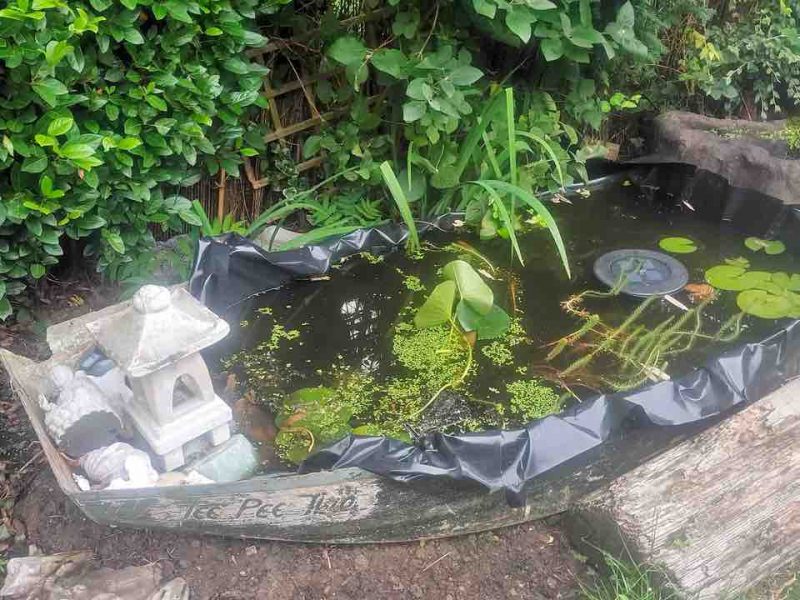
Green water blooms are usually triggered by an excessive amount of light, whether that is natural sunlight or artificial, or an excessive amount of nutrients in the water. So, keeping the right balance of light and food is a good preventative action to avoid green water, as are all the usual maintenance jobs that we’ll talk about in a different section of this article.
If you have a problem with green water, you can use an algae remover designed for aquariums like some of the products in our reviews section, try the blackout method we described above, or use a UV steriliser.
In ponds, you should make sure that the GH value of the water is 12, at a minimum, and also make sure there’s enough bottom substrate. Having water lilies and other plants that float on the water can help with the problem too.
Green hair algae
Green hair algae (GHA) problems are caused by an imbalance of light and nutrients, and excess nitrate which the algae feed on. The nitrate is a result of your pump converting ammonia, so overfeeding can be a primary cause but excessive lighting can be equally to blame.
Named after its appearance, which resembles strands or clumps of wet hair, GHA is not toxic or particularly dangerous but it will use the oxygen in the water when you switch off the lights, and this can cause problems in a few different ways.
It can be incredibly difficult to eradicate green hair algae as a small number of cells can attach themselves to your fish and other items in your aquarium, and even after changing the water and cleaning the tank, those cells multiply and before you know it you have those tell-tale green hairs everywhere again.
While UV sterilisers can be great for keeping green hair algae in check, it will not really remove it, and the best way that I can recommend is to just do it by hand. Obviously, the location of the algae will determine exactly how you will remove it, from scrubbing with a toothbrush on aquarium decorations to gently rubbing down leaves on plants. Using a good algae remover is always a good option too.
String algae (filamentous algae)
Starting off on the bottom of your pond, usually on rocks and substrate, these algae soon grow into long strands that interconnect, and if left unchecked, will cover the top of your pond in a type of naturally woven mat.
This mat can block out sunlight, cause problems with filters and pumps, and generate ammonia; none of which are something you want, so keeping string algae contained is important. In small qualities, there is no problem, and the fish actually use it as a food source.
There are plenty of other types of algae that are found in aquariums and ponds, and writing about them all would take a very long article on its own. However, if you want to look into this in more detail, here’s a list of the most common types to get you started-
- Staghorn algae
- Green dust algae
- Green spot algae
- Euglena algae
- Chara algae
- Black brush algae
- Brown Algae
- Chara/ muskgrass
- Golden algae
Green algae in your garden
The type of slimy algae that you see on wooden fences, decking, and paving stones, is generally just called green algae, and is not only unattractive in appearance, but can cause quite a few problems too.
The main one, at least for decking and patios, is that this stuff is very slippery and leaving it lying around is just an accident waiting to happen. I learned this the hard way, many years ago, and I can tell you that your feet go from under you faster than you would think. I ended up with a bruised shoulder for about a week, and I think I was lucky!
Green algae is not only a slippery hazard, but will also damage the wooden surfaces that it grows on, eventually causing it to split and splinter, and it will stain paving stones if left for too long.
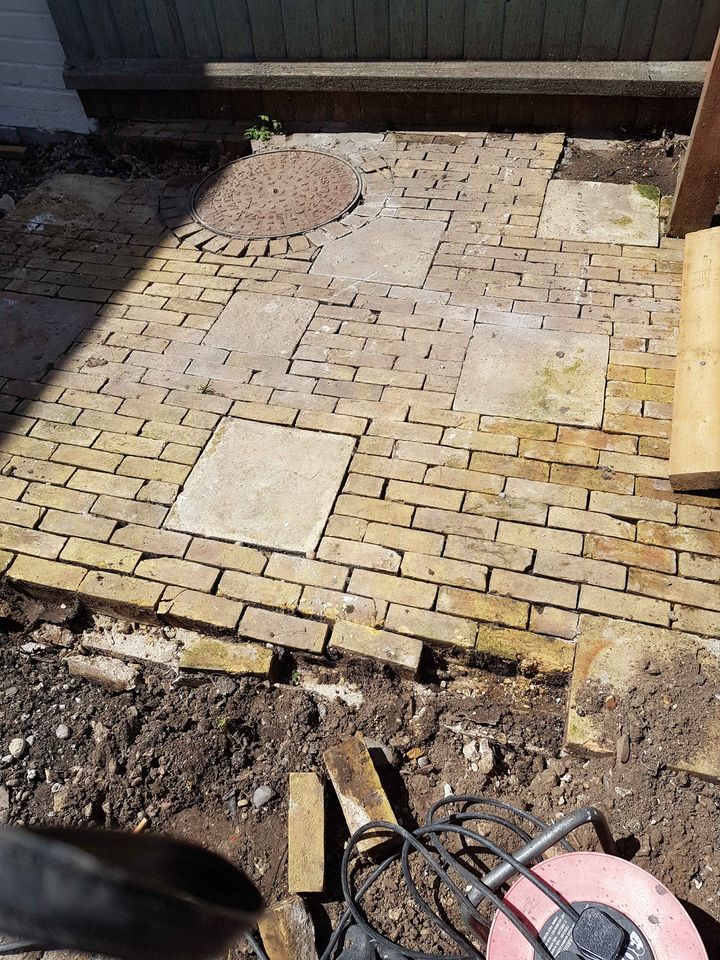
You can quickly get rid of green algae on these surfaces by using a good algae remover, and then blasting it away with a pressure washer. There are also steps you can take to prevent the buildup of algae, as we’ll explore in the following section of this article.
How to prevent algae problems in your pond, pool, aquarium, decking, and patio
Most of the time prevention is better than cure, and so it’s always good to know what you can do to stop algae becoming a problem in the first place. Below you’ll find a few tips on this very subject that, if followed, should put a stop to any green invasion.
Pond
Regular use of water treatments can go a long way to keeping algae at bay, and there are a lot of products on the market that do a great job. These water treatments are effective against both green water and string algae, and shouldn’t cost you too much, especially if you buy in bulk.
Planting things like water lilies and other floating plants, and also various plants that live submerged, can really help in the fight against algae. If you don’t have enough plants in your pond, there will be too many nutrients, and this encourages the growth of the green scourge we call algae.
Pool
Chlorine does a great job of killing off algae spores, so keeping those levels up is a very good idea. You can do this by using a floating chlorinator and also by shocking the pool with an appropriate product.
On top of this, you need to assure that the circulation system, including the skimmer and pool filter, is working optimally. use appropriate products to ensure that you’re cleaning the filter to the best of your ability, and keep up regular maintenance and checks on the whole circulation system.
Other useful things to try are scrubbing the walls of your pool with a brush, using an automatic pool cleaner to deal with debris, and the use of algaecides to keep any blooms at bay.
Aquarium
One of the best ways to prevent algae build up is to control how much light your aquarium is getting. This applies to sunlight and artificial lighting, but sunlight will cause more growth. Artificial lighting isn’t completely harmless though, especially if it is strong light, and even softer lighting should be limited to around 8 hours a day.
An excess of nutrients in the water is a sure way to invite an algae bloom in your aquarium. The most effective ways to avoid this are to feed your fish less, and to change the water often. The combination of these two simple tasks will help more than you would expect.
Introducing algae eating creatures such as Siamese algae eaters, twig catfish, Nerite snails, and others, is a wonderful and natural way to fight off the green, slimy, pest growing in your aquarium.
Decking and patio
Algae are living organisms, and as such they need food to survive and grow. They aren’t picking eaters either, and will make a meal out of any type of dirt and debris you have lying around, so keep your patio cleaned.
The other thing algae needs is water, and as a lot of patios have bad drainage, they are very susceptible to small pools of water forming, and this encourages the algae to grow there. If you have sprinklers set up in areas where the water splashes onto the patio, you should relocate them.
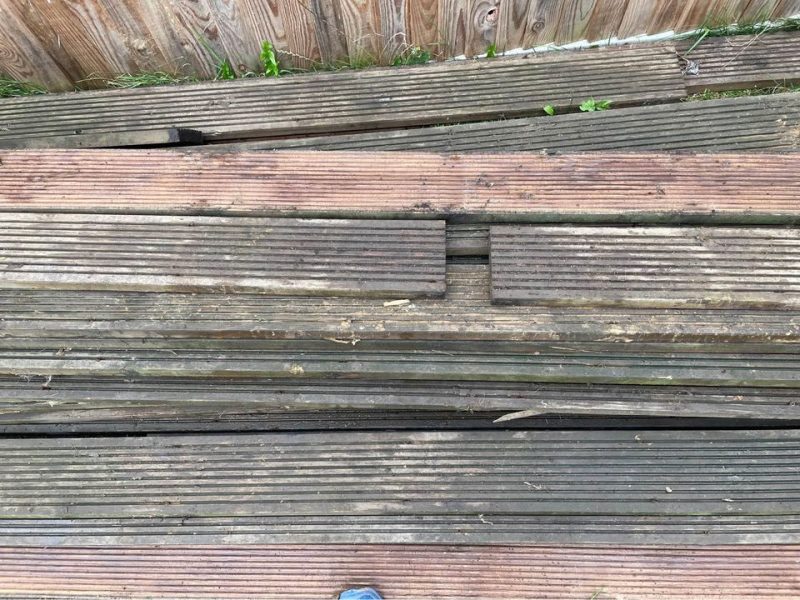
The best way to keep algae off your patio and decking, is simply to use an algaecide product that has been tested and proven to do the job. Make sure you apply it to the area regularly, and keep an eye out for the start of any blooms. Copper sulphate crystals are a good alternative, and you can make a solution with them and apply it to your patio or decking.
Algae comes in many forms and shapes:
Before deciding on which algae, moss, or mould remover to buy, please spend a minute or two looking at our short buyers guide. Here’s a few things to consider-
Ready to use or concentrate.
These products usually come in either ready to use form or concentrate. If you are a person who enjoys convenience, then I would suggest going for a ready to use solution that is already mixed for you. Concentrates are a little messier and need you to measure out amounts and mix yourself, but they offer better value for money and also allow you to dilute the solution differently to suit various jobs, which can come in handy.
Liquid solution or Foam.
Liquid solutions, either ready to use or concentrate are more common, but there are foam products out there, particularly with mould removers. Foams can be less messy than liquids and the foam will stay in contact with the mould for longer which could help with removing it faster.
Liquids tend to be cheaper and you get more for your money. This could be important if you have to treat a large area.
Bleach.
Some algae, moss or mould removers contain strong bleaches, giving them a not so pleasant odour that can cause headaches. These products can also stain and discolour surfaces if you are not careful. However, these products are often the most affective at shifting growth, but not always so. If you’re worried about damaging your surfaces, go for a bleach free solution.
Know what your product is meant for. Some products are all-in-one and can remove algae, moss, mould, and more, but others are more specialised and only mean to tackle a particular problem. Make sure you read up on a product before you buy it as it may not be the best option for your needs.
Follow the instructions.
To get the most out of any algae, moss, or mould remover, you need to follow the manufacturer’s instructions to the letter. Failure to do so will more than likely give you less dramatic results or even stop the product working. In general, you want to spray when the weather is bright and dry. Spray in the late afternoon as direct or strong sunlight can cause the solution to evaporate. If it rains within a few hours of applying the solution, you will probably have to wait for the area to dry and then spray again.
Also, give the product time to work. Often the advertisers will tell you a product shows results after 2-3 days, but in my experience it usually takes longer to see a noticeable difference.
Why buy the best Algae remover – what can it really clean?
Patios, garden paths, decking, and stepping stones are all very common features in gardens across the UK, and for good reason. There is nothing quite like sitting out there on a summer’s day, relaxing on your garden furniture, while the barbecue cooks a spot of lunch.
Now, I know I’m being idealistic here and the reality is somewhat different. Usually, the truth is, you go outside after months of winter weather to see your patio has been slowly colonised by algae, lichens, and moss, leaving an ugly patchy green layer covering your normally beautiful paving or the deck is slippery and desperately needs a quality deck cleaner! This layer isn’t just an eyesore, it can also be potentially dangerous as it is usually very slippery and you don’t want your kids running around on it. It’s not just the decking either, this will work on wooden table and chair sets too.
There is also the problem of mould growing on your garden furniture, especially if it has been stored in a dark and damp place like a shed for a while. So what to do about these problems? Well, it depends on the severity of the growth and a few other factors.
Some people like to use a pressure washer to blast out moss from between paving stones, and this can be quite effective, especially on wooden garden furniture. However it is also very messy and some of the excess water could get trapped in certain areas and make the problem worse. You could also scrub the algae, moss, etc. off by hand using a hard brush of some kind but this is quite labour intensive.
Then there are specialised chemicals that are designed to make the removal of algae and other similar growths much easier especially patio cleaners which can have ultra stubborn growths. It is these products that we will be reviewing today to find the best algae, moss and mould remover.
Best Algae Remover reviews:
1. HYDRA Fountain Clear
Is your water fountain looking a little worse for wear? Green water and slimy plant life slowly overtaking the garden feature that was one of your pride and joy?
Well, if that’s the case then you should definitely buy yourself some Hydra fountain clear algae remover. This stuff works incredibly well, both as shock dose (1:10,000) and mixed down in a maintenance dose (1:30,000).
The shock dose is particularly fast acting, and you’ll see a noticeable difference within a few days, returning your water and fountain back to its old self. It will do this without staining or damaging the fountain either, no matter if it is made from stone, brass, steel, or resin.
With a long shelf life of around 3 years, you certainly won’t be wasting any of your Hydra fountain clear, even if you buy multiple bottles, and the fact that it can be used to both shock and maintain means that you won’t need to buy a separate product.
This can only be used in water fountains though, and is harmful to fish, so don’t be thinking of putting this in your pond or aquarium. However, it is non-toxic to birds and other wildlife, so don’t worry about it if you see a winged visitor sat on your fountain.
Pros
- Specifically formulated for use with water fountains
- Can be used as a shock dose or maintenance depending on mixing ratio
- Won’t damage your fountain, no matter what material it’s made from
- Very long shelf life ensure you get your money’s worth
Cons
- Toxic to fish and can’t be used in or near ponds
Fancy taking a closer look at this product? Well, here is a video doing just that. Enjoy-
2. Patio Magic Patio Cleaner 5L
Our top pick has to be the 5 litre version of Patio Magic’s patio cleaner. We chose the 5 litre bottle in particular because it comes with its own battery operated spray gun. Just pop in the 4 AA batteries that come with the patio cleaner and you’re ready to go attack that mouldy growth.
The spray gun is a compact plastic device that can be held comfortably in one hand while you carry the patio cleaner solution in the other, and because it is battery operated, you don’t have to keep stopping to pump up the pressure. While the spray gun is not the highest quality available, it will continue to do its job properly if you treat right and look after it, just like any garden tool. There is a concentrate version of this patio cleaner available if you prefer to dilute it yourself, but I actually like the convenience of this one being premixed and ready to go, as it saves on both time and guesswork.
It is easy to use too. Just spray it on the hard surface where the problem is and leave it to dry. It is important that the area that you’re working on is dry, without any puddles or areas of trapped water, and also that it is not expected to rain for the next 24 hours at least. For best results you should spray on a dry sunny day and this should let you see a noticeable improvement within 4 days or less and over a longer period of time (weeks) it can work wonders so some patience is required.
Patio Magic’s patio cleaner is completely biodegradable and won’t leave any residue or stains behind. This also means that once it has dried, it poses absolutely no risk to your children or family pets, and they are free to play in the sprayed area. Just make sure that it has completely dried up before though and this usually takes about 5-6 hours depending on conditions.
After treating the desired area, the algae removing effects should last about 6 months but this could be less if the area is constantly in the shade or poor drainage keeps the area damp. I would spray again after a few months anyway just to make sure. I’ve always thought it’s better to be proactive when dealing with moss and mould.
Now for the downsides. It should be pretty obvious that spraying this algae remover should be done very carefully as to not get it on your flower beds and foliage a sit will probably damage them. I accidentally over a sprayed on one area and it did kill the flowers next to it.
Also, with some particularly thick lichens and black spots it struggled but that is nearly always the case and jobs like that usually need a stronger more industrial strength cleaner. You will also still have to do a little scrubbing with a brush, no matter what Patio Magic claim, but this algae, moss and mould remover does make it much easier to get the growth off without too much elbow grease. Don’t forget to use a good patio sealer straight after to stop dirt and new growth for as long as possible!
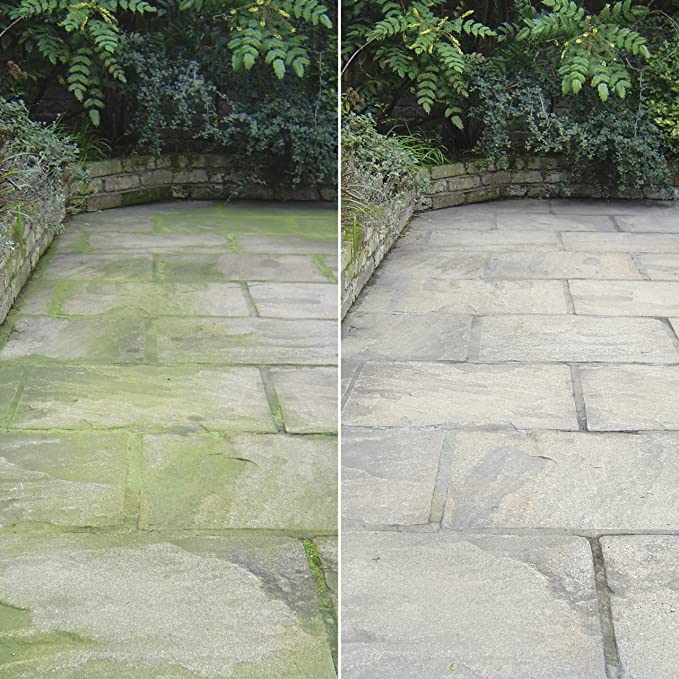
3. Patio Magic! Concentrate
Patio Magic! Concentrate is a real quality product for Algae so I’m listing the cheaper option too 🙂
For ridding your patio of green algae, there are few products that work as well as patio Magic concentrate. Providing that you use it the right way, that is.
You see, I have a lot of experience with testing and using patio cleaning products, and when it comes to algae and moss removers, I’ve figured out how to get the most out of them. Basically, it all comes down to the weather conditions when you apply the algae remover, and for the few days following that.
Ideally you want it to be clear skies and sunny, but warm and cloudy is ok too. If you have rain, even light rain or drizzle, or that part of the patio is in constant deep shade, it will seriously impact the effectiveness, so timing is everything.
If you get it right, you will be rewarded with a beautiful, green, algae-free patio within a few days, and one that will continue to be protected for a while afterwards, as long as you do maintenance coats every now and again.
Patio magic is extremely easy to apply. You just mix it with water, and then either spray it on with a garden sprayer, or pour it on the patio and use a brush to spread it around. I personally use the second method, and I always mix my solution slightly stronger than the recommended ratios, just to make sure.
The downside to this stuff, is that it is highly toxic to fish and animals, so keep your pats away until it dries completely, and make sure there’s no run off towards your garden pond when you apply it.
Pros
- Very effective at clearing green algae
- Very easy to apply to patios
- With regular coats, you can reduce the risk of future outbreaks
- Fast acting if used in the right conditions
Cons
- Won’t work well in wet weather
This product is available in various sized bottles, and some 5 litre bottles come with their own mini sprayer-
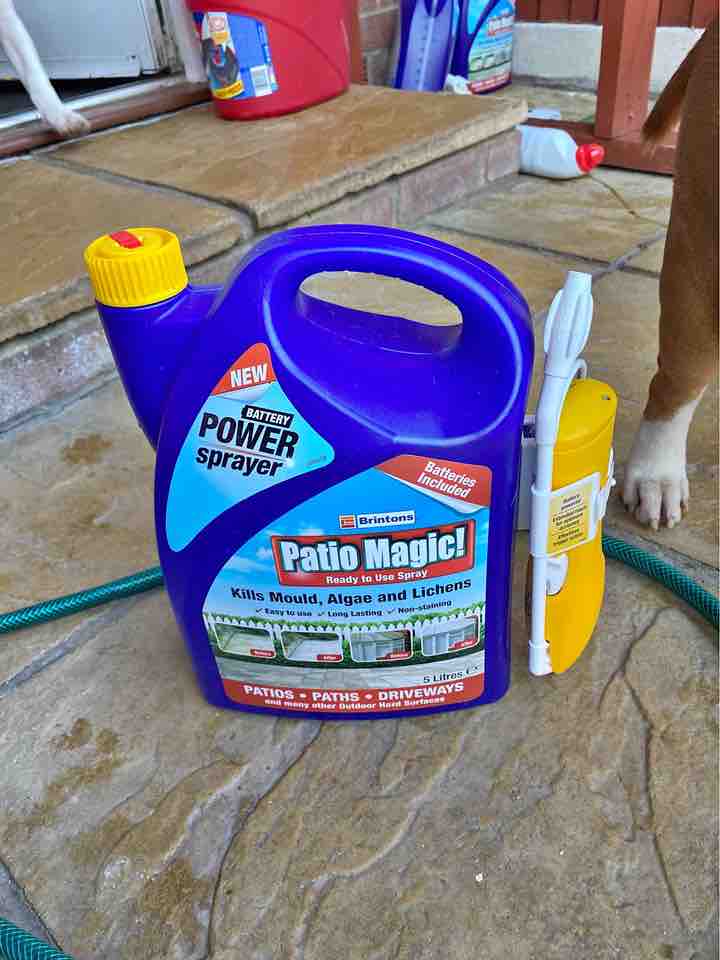
4. API Prevent Algae Aquarium Algae Control Solution, 237 ml Bottle
API Prevent Algae is a product that definitely lives up to its name, clearing up green water problems within a few days. However, you have to follow the instructions carefully so as to not run into problems.
This product works by removing phosphate from the water, a nutrient on which algae thrive. It does this very effectively, and you will see a difference in the clarity of the water, but as you are removing nutrients from the water, you really need to keep monitoring the conditions in your tank during this process.
The thing is, keeping an aquarium and your fish healthy is all about balance, and by removing a nutrient like phosphate you are changing the balance slightly. It’s for this reason that I suggest you keep an eye on everything, so you can see if anything needs adjusting.
If used properly, along with partial water changes, filter changes, and gravel cleaning, you should have no problem keeping your aquarium in top-notch condition, free of green water and other algae issues.
The only issue I can see with this product, if used properly, is that the effects don’t last forever, and you will have to keep applying it regularly. This could end up costing a small, but significant chunk of change over time, but I guess it’s better than having an ugly, murky tank in your home.
Pros
- Reduces the amount of phosphate in the water
- Very effective at clearing algae from aquariums
- Fast acting and you will see results within days
- Regular use will keep your tank healthy and prevent algae problems
Cons
- You have to monitor your water condition while using it and it shouldn’t be used with invertebrates in the tank.
Check out how well this stuff work in the following clip:
5. Clearwater CH0006 Algaecide Algae Remover for Swimming Pool and Spa Hot Tub
One of the most effective algae removers for pools, Clearwater algaecide is just the thing to keep your family swimming, paddling, and just generally enjoying the water once summer rolls around again.
This BISHTA approved product has been designed to reduce and eliminate algae build up in swimming pools, paddling pools, and hot tubs, making it a versatile algaecide that will come in handy when the weather gets better.
When used in pools and hot tubs, it is really important that you check the water’s PH and chlorine levels before applying this product. If they are not within the right range, you might find its effectiveness suffering.
We followed the instructions to the letter, delivering a shock dose at first and then a weekly dose of half the shock amount once a week for a month. I have to say that we were very impressed by Clearwater’s ability to tackle algae from the surface of a particularly grungy looking swimming pool.
Although the well known hot-tub brand, Lay-Z-spa, recommends clearwater for their hot tubs, I actually couldn’t find any directions on the bottle that referred to hot tubs in any way. I also didn’t test it in that way, so I can’t speak to its suitability or effectiveness in that department. For pools though, it’s a winner as far as I’m concerned.
Pros
- Excellent choice for keeping swimming pool surfaces clear of algae
- BISHTA approved product
- Recommended by Lay-Z-Spa for their hot tubs
- Gets to work quickly and will keep algae at bay if treated regularly
Cons
- I couldn’t find any reference on how to use it for a hot tub in the instructions on the bottle.
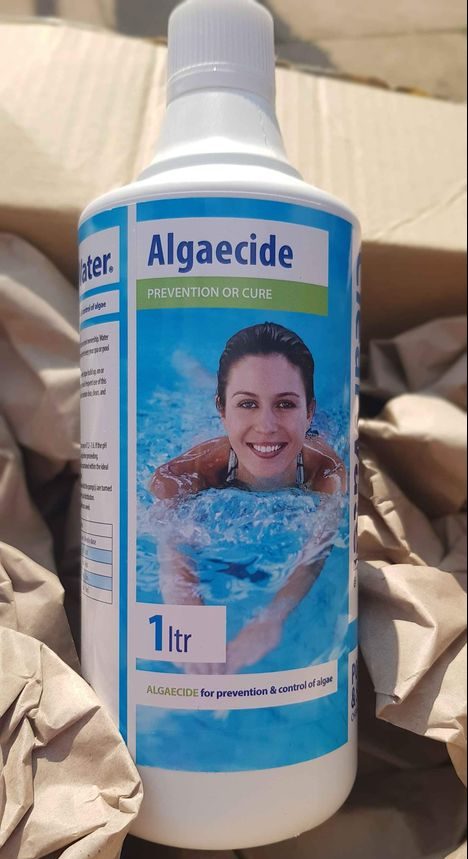
6. CLEAR waters Nishikoi Blanketweed Treatment 1L
String algae, AKA blanket weed, can be an absolute pain in the backside, and once it gets established in your pond, can cause all kinds of headaches for you.
Clear Waters’ blanket weed treatment is probably the best product I’ve ever used to tackle this particular issue, and will take care of slime algae at the same time too. It works by taking away the nutrients that algae need to survive, effectively starving them into submission.
One of the best things about Clear Water’s blanket weed treatment is that you don’t have to wait until the weather gets better to use it. Effective at clearing algae in ponds with water as cold as 4 degrees Celsius, this product can be used all year round. Just make sure to wear your wooly hat and gloves.
You don’t have to worry about fish or the local amphibians suffering either. This product will not harm them as long as you stick to the recommended doses, even after multiple treatments.
You have to be aware that this isn’t a one use and problem solved thing. You will need to keep up the treatments regularly, and if you forget for a couple of weeks, expect to see that blanket weed starting to make its way back.
If you have a really bad blanket weed problem, I would suggest removing most of it by hand first, and then using this product to kill off the rest and keep it in check. It’s good, but it’s not a miracle cure.
Pros
- Does an amazing job of tackling blanket weed in ponds
- Can be used in colder weather conditions and water down to 4 degrees Celsius
- Won’t harm your fish if you stick to recommended doses
- Removes nutrients that algae need to survive
Cons
- You’ll need regular doses of this product to keep control of blanket weed in your pond. However, as you can see from the video below, it is effective stuff:
7. Pro-Kleen Patio Cleaner Simply Spray & Walk Away Concentrate
Decking is often a victim of green algae, and can be extremely slippery once the green stuff gets established, so it’s good to know that there are products like Pro-Clean’s Simply Spray & Walk Away (I’m not saying all that again, so from her on out I’ll refer to it as SSWA).
This is a product that does exactly what it says it will, and you just have to mix one part to four parts water, fill up a garden sprayer with your solution, and spray down your decking, garden furniture, and pretty much any other outdoor surface you like. Wait a few days, and then you’ll see the difference.
Just like with Patio magic, you need decent, clear weather to get the most out of SSWA and also a little patience and it won’t work overnight. It will help to keep future growths under control too, but you’ll need to respray from time to time.
SSWA doesn’t contain bleach or highly toxic chemicals, but you’ll still have to wait until the area fully dries before you allow your kids or pets around there, and you should definitely avoid any runoff onto your plants and into your pond, despite the claims that it is biodegradable. It’s always better to be safe than sorry.
I found it did a cracking job on our decking, and didn’t leave any stains or marks on the wood either. I also tried it on some green algae on the base of a garden wall, and I have nothing to grumble about there either.
Pros
- Very easy to use
- Lives up to its name – just spray & walk away
- No highly toxic chemicals and pets and kids are safe once it has dried
- Leaves no marks or stains behind on decking
Cons
- Make sure it doesn’t run off into your pond as it can be harmful to fish.
8. HG Mould Remover Foam Spray
HG Mould remover is a versatile product that can be applied onto range of surfaces from plaster walls to garden statues, and from bathroom tiles to hot tubs. While primarily used for indoor surfaces, it can also work well on things you find in the garden. Particularly swimming pools, garage floors and surfaces and planters. It is important to note, however, that this is only for removing mould and not algae, moss, or lichens.
As a mould remover though, this product is excellent and also easy to apply. All I needed to do was spray the foam onto the mouldy area in my bathroom and leave it for half an hour. Then I came back and wiped the area with a sponge and the mould had all but disappeared. There was a damp patch on the wall where I had sprayed that had me worried, but this dried out without leaving any stain or mark within the day.
I think the reason this mould remover works so well is that it is a foam and sits/sticks to the mould while it removes it. You can actually see and hear it working the instant you spray it on (or maybe that was just my overactive imagination haha) and it also has the added benefit of not running down instantly from the sprayed area onto more sensitive materials such as fabrics. There will still be some run off though once the foam dissolves into liquid so be careful with that.
As with everything, HG mould remover foam spray does have its faults. Most noticeably is the strong smell that reminded me of when someone has been overzealous with chlorine in a swimming pool. For this reason it is a very good idea to have the room properly ventilated when using it and also wear some breathing protection to keep it out of your lungs. Also, leftover liquid can block up the nozzle so you will probably have to clean it out with warm water before each use.
Apart from these small flaws, HG mould remover is a good product that does what it claims and is particularly impressive when tackling black mould from ceramics and stone. It would be a good product for cleaning a hot tub or similar.
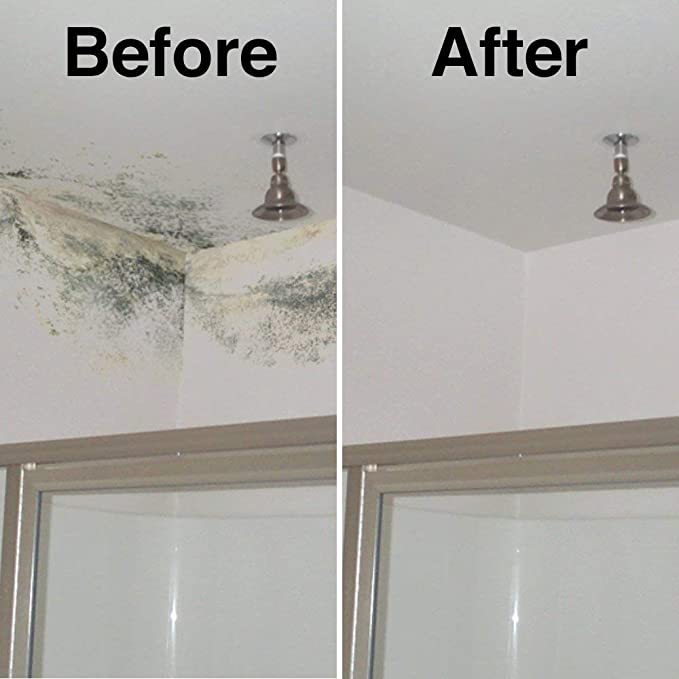
9. Jarder Spray & Leave 4 x 5 Litre Concentrate Cleaner
For just over 30 quid you get 4×5 litre bottles of Jarder Spray & leave concentrate cleaner. With each 5 litre bottle able to produce 30 litres of solution once diluted, that’s good value for money. Jarder Spray & leave is meant for outdoor use and will help you get rid of all the usual culprits such as algae, moss, and mould from fencing, decking, patios, and just about every other garden surface you can think of. Caravans have become increasingly popular in recent years, so it is good to know that you can use this product on them as well as boats, and even on uPVC windows, the most common type of window in the UK.
I tested this on my garden path which had a fairly thick growth covering it after a harsh North East English winter and I was happy with the results. I followed the manufacturer’s instructions to the letter, making sure that I sprayed the path in the late afternoon on a bright and dry day using a pump action garden sprayer and left it to do its job.
I was expecting results after 2-3 days, and while there was some improvement, it wasn’t as good as I had hoped. However, after another couple of days I could really see the difference and after another week or so it had really done a good job.
I was worried for a while after spraying as a whitish colour to my path not too long after spraying, but after looking online I realised this was normal and this disappeared before too long.
While this algae, moss and mould remover is harmful to plants and flowers, and also fish, once dried out it is safe for your dog and kids to play in the area. Depending on the concentration level that you mix it at, this product could also damage your grass, so that is something to keep in mind.
Talking of concentration levels, one of the nice things about having an algae and moss remover in concentrate form is that you can tailor it to suit your needs. I liked the ready to use Patio magic patio cleaner for convenience and ease of use, but it did struggle with lichens. With this product you can simply dilute it less, or not at all, to tackle those hard to shift growths. Just be careful with it.
One thing I will say about this product though is that while it did a good job of shifting the algae, it did take a while to work the way Ai thought it would and after a month or two I started to see signs of it growing back, so more applications would be needed to keep your patio or path algae free all year round. Still, with 4×5 lites of concentrate, you would have more than enough to do that.
10. ULTIMA-PLUS XP Patio Cleaner 5 Litres Super Concentrate
The biggest selling point of Ultima-Plus XP is that it is not only a very affective algae, moss and mould remover, but also that it offers incredible value for money. It is not called super concentrate for nothing and the high strength formula only requires one part concentrate to be mixed with 9 parts water. This means that you can get 95 litres of working solution out of a single 5 litre bottle of concentrate. For easier jobs such as very light algae or moss, you could even dilute it further.
Like most algae, moss and mould removers, you are advised to apply it during spells of dry weather, but not during the middle of the day as intense sunshine can evaporate much of the product leaving it much less effective.
Following these instructions, I used the Ultima-plus on some fencing that had some quite thick growth on it. The bottom of the fencing spends a lot of time in the shade so the algae was particularly bad there. After spraying, I left it to go to work and waited to see the results and was not disappointed.
After a week, the solution had done a great job of breaking down the growth and I only needed to brush the remnants off, which was an easy job as there wasn’t much there, and the fence looked as good as new. There was no discolouring or staining on the wood either. This was done a few months ago, and to this day the fence is still growth free and looking great after I used a decent fence stain, so this says something about the long lasting protective effects of the solution.
The Ultima-Plus XP patio cleaner can be used on just about any hard outdoor surface from bricks, wood, and stones, to roof tiles, and because it isn’t a bleach based solution, it won’t stain or damage your garden statues or patio floors. It is also biodegradable and non-caustic so it won’t corrode any of your more delicate surfaces.
The downside of this product is much the same as many others of its type, namely the strong odour so please wear a mask when using this product and if you’re using inside, make sure the area is well ventilated.
There you have it folks, a fantastic selection of the best algae removers for pools, ponds, aquariums, decking, and patios, for you to choose from. Whichever you decide suits your purposes, please read the instructions carefully, and follow the directions to a tee for best results.





































